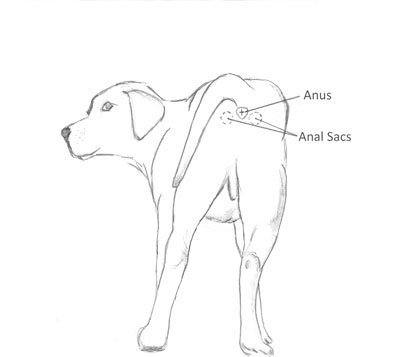Dog Anal Sacs

Anal sacs are internal scent glands located adjacent to the anus in dogs. The glands secrete a strong-smelling substance that empties onto skin and anal tissue through ducts. These watery secretions are usually tea-colored, yellow, or grey-brown. Some people describe the odor as fishy or musky; most agree that it is distinctive and not particularly pleasant.

What Are Canine Anal Sacs For?
Anal sacs assist in scent identification and marking behaviors. They are compressed by stools during defecation and expel glandular material (anal sac fluid) along with the bowel movement. The sacs can also empty with exercise, fear, agitation, or self-defense.
What Is Anal Sac Impaction?
Sometimes the sacs do not normally empty with these routine activities and become impacted. Anal sac impaction is an extremely common condition in clinical veterinary practice. Sometimes the anal fluid will harden, and normal sac emptying becomes a painful process. This can cause great discomfort and is the foremost reason for rear-end scooting in dogs; if left untreated, impacted anal sacs can become infected or abscessed. Some dogs require regular anal sac expression, while others will never have an issue. High-fiber diets result in bulky stools that may help in compression of the sacs and may be useful in chronic case management. Hypoallergenic diets may be useful as well.
What Is Anal Sac Expression?
The discomfort of impacted anal sacs is often relieved by squeezing the sacs to remove the trapped fluid. Expressing can be performed internally or externally, but internally generally empties the sacs more thoroughly.
During internal expression, a gloved finger is inserted into the rectum and each gland is squeezed individually with the finger and a thumb. The thumb and finger are placed externally over each gland, and both glands are squeezed together with external expression. Internal expression may empty glands more effectively than external expression. Please seek advice regarding anal sac expression from your veterinarian and do not attempt it at home.
What Are Signs of Anal Sac Disease in Dogs?
The most common sign of anal sac disease in dogs is scooting of the rear quarters along the ground. Other signs can include a foul odor, redness around the anus, and a pus-like discharge. Dogs may lick aggressively and continuously around the anus and tail area. The skin surrounding the area may be red and irritated as a result of the licking.
What Are Other Types of Anal Sac Disease?
Anal sacculitis is usually caused by inflammation of the sacs. This can progress to bacterial infection of the sacs and anal sac abscesses. Perianal fistulas (long inflamed tracts in the skin surrounding the anus) are usually formed secondary to inflammation or infection but can also form due to immune conditions. Lastly, cancers of the anal sacs and perianal tissues can be seen, as well.
How Are Anal Sac Conditions in Dogs Diagnosed?
Many of these conditions can be diagnosed and treated on physical examination. Most veterinarians will need to perform a digital rectal exam, as well. If necessary, your veterinarian will recommend blood work, x-rays, fine needle aspirate and cytology, or biopsy to confirm the diagnosis.
How Are Anal Sac Problems in Dogs Treated?
Treatment depends on the diagnosis. Common treatments include expression, anal sac flushing, soothing creams, antibiotics, and anti-inflammatory medications. Dietary modification is often used to prevent recurrence.
You May Also Like These Articles:
Bloat in Dogs: Gastric Dilatation and Volvulus (GDV)
How to Be Prepared for Your Dog's Veterinary Bills
Giving Your Dog Clean and Fresh Water
Disclaimer: This website is not intended to replace professional consultation, diagnosis, or treatment by a licensed veterinarian. If you require any veterinary related advice, contact your veterinarian promptly. Information at DogHealth.com is exclusively of a general reference nature. Do not disregard veterinary advice or delay treatment as a result of accessing information at this site. Just Answer is an external service not affiliated with DogHealth.com.
Notice: Ask-a-Vet is an affiliated service for those who wish to speak with a veterinary professional about their pet's specific condition. Initially, a bot will ask questions to determine the general nature of your concern. Then, you will be transferred to a human. There is a charge for the service if you choose to connect to a veterinarian. Ask-a-Vet is not manned by the staff or owners of DogHealth.com, and the advice given should not delay or replace a visit to your veterinarian.



